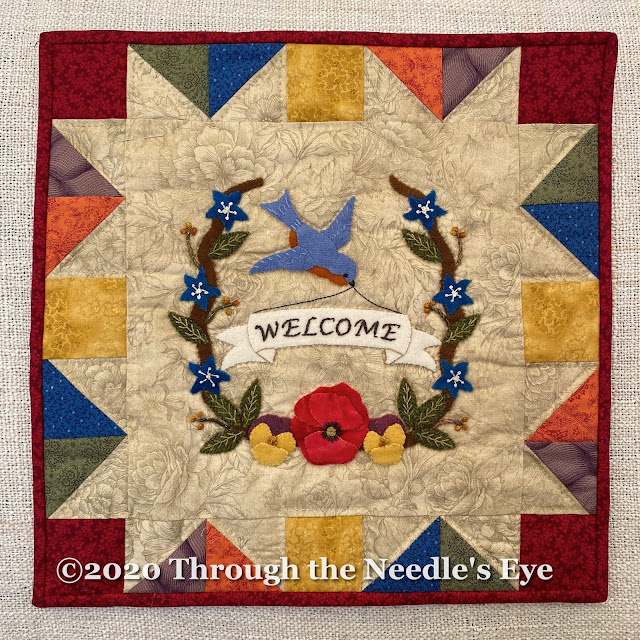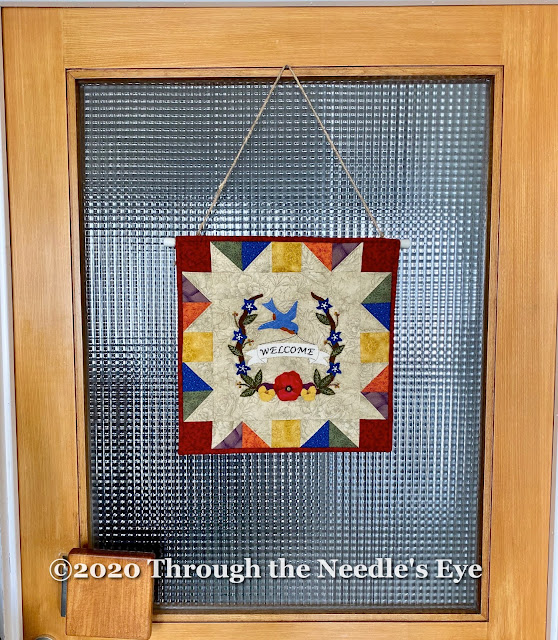Last week, Kara share a tutorial for appliquéing tiny circles. It seems that we appliqué artists never run out of circles to stitch in our designs, so I (Teri) thought we might look at a few other methods, and focus on one of my favorites.
Circles, like the soul, are neverending and turn round and round without a stop. ~Ralph Waldo Emerson
As Kara noted last week, when we taught this first class a few years ago, this block (an Elly Sienkiewicz design) needed some small berries. In my version of the block, I made the berries in three different ways, so that I could vary the texture—and of course, demonstrate three techniques for making small circles.
A circle is a round straight line with a hole in the middle. ~Mark Twain
There was panic on a couple of faces when seeing how small those berries are. Why do we fear the circle? We need not—there are so many ways to approach a circle, and with all the choices, you are sure to find one that you love. And some ways are just so easy! So let's add to our circular toolbox.
Three ways to make these tiny berries.
By far, the easiest method is to use ultra suede. You don't need to turn under the edge, and it is easy to cut to any size. I've even used it for a tiny bird's beak. A thin, sharp needle sews through it with no problem. Easy as pie; nothing to fear.
The very bottom berry in the photo above is made of a group of Colonial knots, or you could use French knots. It gives a raspberry effect. Also simple, and it gives an interested added texture to your piece. Variegated thread, like the Valdani I used here, also adds a spark.
A circle is the longest distance to same point. ~Tom Stoppard
Let me tell you about my favorite circle.
The Spiral Trellis
A Tutorial
1. Draw your circles onto your background. Backstitch around the circle, directly on the drawn line, in a counterclockwise direction. Here, I've used #12 Valdani pearl cotton, but you can try it with many different kinds of threads for various effects.
2. When the circle is closed, put your needle under the next stitch to the left, about halfway. At this point, you may want to switch to a tapestry needle or use the eye, so you do not have a sharp tip piercing the thread. All of your work will now be on top of the ground fabric.
3. Wrap the thread around the needle from the front around to the back in a clockwise direction. Pull the wrap taut.
4. Holding the thread in place, pull the needle through, forming a knot. Repeat in each stitch, moving counterclockwise around the circle.
5. When you have gone around the circle in all the backstitches, you will continue by putting your needle in between the stitches, wrapping and knotting as before. This is the only tricky part; at first you almost have to “feel it,” but with each round it gets easier to see where your needle should go. Don’t give up! It’s worth it!
6. When your berry is close to being filled, skip to every other stitch.
7. For your last stitch, pull the needle into the stitch, through to the back and knot off.
Aren't those spirals pretty?
Over the years, I have grown to love this special stitch. It just adds such fun texture and even a bit of dimension to my work. Here are a few ways I have used this gem of a stitch.
On my redwork fairy tale quilt—a near-future post—my crown needed jewels, and the spiral trellis was perfect for a butterfly head. Here, I used two strands of The Gentle Art floss.
Family Tree House pattern from Baltimore Elegance, by Elly Sienkiewicz.
Here, I used Wonderfil #5 pearl cotton thread, from Sue Spargo's Eleganza collection. It was great fun to see how each pattern was different due to the variegation of colors.


One our new designs has swags of asters, and the spiral trellis was perfect for the flower centers. These are also made with #5 pearl cotton, by Weeks Dye Works.
After finishing the asters, I began working on the border of my fraktur quilt, which had berries. I was working with wool, so it would have be SOOOO easy to cut them out of wool and stitch them down. But I thought the dimension of the spiral trellis was just what it needed. So I made 36 of these little berries. And I loved them. But I might be ready for a short break from my favorite stitch.
Have you tried the spiral trellis stitch? I hope you might give it a go, and see what you think. It is a fun way to add some pizzazz to your circles!
Like a circle in a spiral, like a wheel within a wheel
Never ending or beginning on an ever spinning reel
As the images unwind, like the circles that you find
In the windmills of your mind!
~Alan and Marilyn Bergman




















































